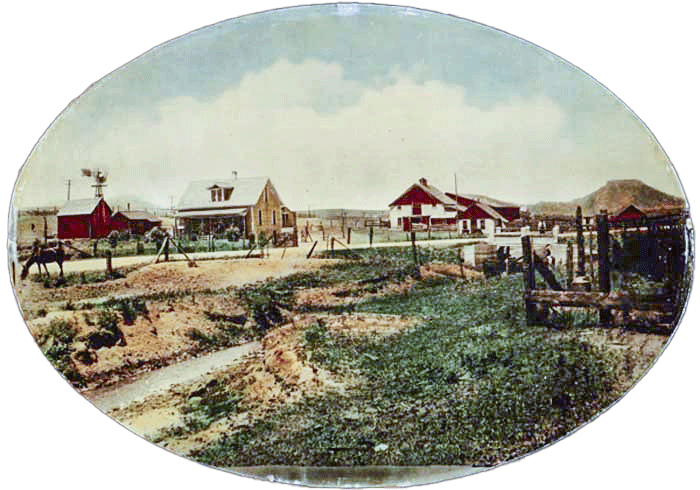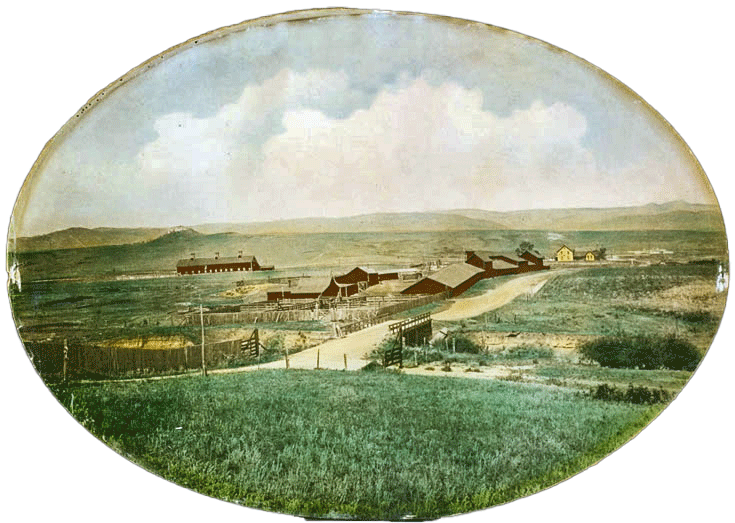Lightning strikes twice
…in Greenland

Until it burned to the ground again on May 11th of this year, the tallest building in Greenland, Colorado was a weather-seasoned red barn that was first built by Isaac Jegirtha Noe in the mid 1880s. His original three-cupola structure was first incinerated from a lightning strike in 1922. New owners at that time, the Higby brothers rebuilt it in that same year, but with only two cupolas and 25 feet shorter in length. Local backstories of this quaintly named locale are fascinating…

The Allis Ranch, circa 1913. The family raised milk cows and prize-winning Hampshire sheep. (Photo courtesy of Ida Mae Noe and Larkspur Historical Society.)
Originally called Pinedale, accomplished author, poet and Native American activist Helen Hunt Jackson gave the tiny 20-acre community its current name, and Fred Solomon platted it. Averaging 7,000 feet in elevation, greater Greenland nestled up against the Palmer Divide and received healthy doses of annual rainfall. Its microclimate was ideal for growing potatoes, grain and also nurturing cattle, sheep stock and small dairying operations. Adjacent foothills and Spruce Mountain made it attractive for lumbering and sawmills. Carpenter Creek ran through the middle of town.
Given its fertility and broad open expanses, a handful of settlers were early big ranch thinkers, piecemealing original land claims into far larger holdings. The once 20,000-acre Greenland Ranch was developed this way in the 1890s, primarily by C.B. Kountz with I.J. Noe as his agent.
The community had early star power. A.B. Daniels was a Castle Rock banker who built the original ranch. James Nemerick, noted musician and politician, owned land dominated by the buttes east of today’s I-25. His daughter Nellie, though stricken with tuberculosis, found it within her to climb to the top of a butte, marking it with a large rock cairn that stands to this day. Today, the butte is known as Nemerick Mountain.
In adjacent Huntsville, our fourth Colorado governor, Alexander Hunt, consolidated his own large ranching operation at the top of the escarpment, on the east side of I-25 and across from today’s Jellystone Park.
By 1871, General Palmer’s Denver and Rio Grande Railroad (D&RG) reached the small community. In 1887, the Atchison, Topeka and Santa Fe Railroad (AT&SF) did as well. Business was brisk and both railroads had depots serving the townsite. I.J. Noe’s barn was often serenaded by whistles, as it was located between the AT&SF tracks on its west side and the D&RG tracks on the east.

The original barn 36 x 101 feet, part of the then-named Greenland Breeding Farm. (Photo courtesy of the Douglas County Record Journal, 1921 and Larkspur Historical Society.)
There was a time, one year, when the local crop of potatoes filled some 400 railroad cars! This, from a town of less than 50 citizens. The townsite is marked today by the frontal façade of Higby’s Mercantile.
Fast forward and John Malone, noted telecommunications maestro, would in time acquire the Greenland Ranch, known today as the Harmony Conservancy. But for 3,600 acres of open space, the massive ranch operates today within the confines of a nature conservancy funded by Douglas County tax dollars and those received from Great Outdoors Colorado.
Ah, the barn…What if anything will rise from today’s ashes remains to be seen. But speculation continues. Some folks given to such sport seem to think the two sets of railroad tracks that straddled the barn were indeed horizontal lightning rods. Could it indeed be true? We will probably never Noe…
By Joe Gschwendtner; courtesy photos